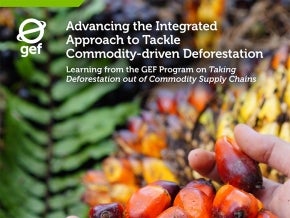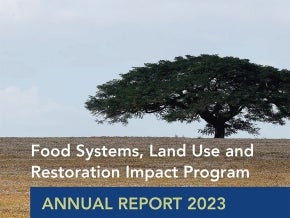
The Global Environment Facility was created to protect the global commons, and funds projects to address climate change, biodiversity loss, land degradation, sustainable forestry, international waters, and chemicals in more than 170 countries. Since 1991, it has provided $17.6 billion in grants and mobilized an additional $88.6 billion in financing for more than 4,453 projects.
The ecosystems, biomes, and processes that regulate the stability and resilience of the Earth system are under severe pressure. The science indicates that several planetary boundaries have been breached, including loss of biodiversity, and land use and climate change. As the Facility approaches its quadrennial replenishment in June 2018, it is timely to reflect on how understanding of tackling environmental problems has shifted, and what factors make for successful outcomes. We clearly need transformational change, and at scale, to make a dent in burgeoning global environmental problems.
Four of the top five risks in the Global Economic Forum’s Global Risks Report 2017 are environmental. There is increasing recognition that a deteriorating global environment poses significant threats to the prospects for future economic growth and development. Nor will we succeed in delivering the Sustainable Development Goals in the absence of a stable and healthy Earth system.
The notion has long gone that environmental problems can be dealt with singly in silos. Simply setting up protected areas to reduce biodiversity loss will not succeed when much of biodiversity is found in areas under production, both in agriculture and in the seas. Further, as climate changes, shifting species' ideal ranges, ecosystems within protected areas will be dramatically altered. Protected areas are important, of course, but they are only part of the answer. We therefore need innovative ways of integrating development and protecting biodiversity. And we also need to ensure that we do not inadvertently make things worse, for example, by expanding agriculture in ways that deplete soils, use water unwisely, harm pollinators and bring deforestation. Otherwise efforts to increase food production will eventually prove self-limiting.
The Facility is pioneering three new Integrated Approach Pilots addressing the major drivers of environmental degradation. In “Fostering Sustainability and Resilience for Food Security in Sub-Saharan Africa”, it is pursuing agricultural transformation and intensification which is both sustainable and resilient through integrated management of the natural resources – land, water, soils, trees, and genetic resources – that underpin the security of food and nutrition. “Taking Deforestation out of Commodity Supply Chains” is tackling the expansion of commodity production for beef, soy and palm oil, which accounts for about 70 per cent of deforestation globally. It is introducing integrated supply chains which embed sustainability principles and better practices, while supporting conservation and protection of forests. “Sustainable Cities” is implementing sustainable urban planning and management initiatives to deal with urban population growth and expansion as a driver of environmental degradation.
The Scientific and Technical Advisory Panel – an independent group of scientists advising the Facility, which I chair – has been considering elements of good practice in tackling complex environmental challenges through integrated projects and programmes. We propose six key elements, based on our review of the literature and Facility’s experience:
- Applying systems thinking, i.e. addressing inter-connected environmental, social, economic, and governance challenges across sectors with an eye towards resilience and transformational change.
- Exemplary stakeholder engagement, including with local communities – not just government officials – from the inception and design of a project through to its completion. This is crucial for identifying diverse needs and managing trade-offs.
- A clear rationale and theory of change to tackle the drivers of environmental degradation through assessing assumptions and outlining causal pathways – and having a ‘Plan B’, should desired outcomes not materialize.
- Explicit plans and funding for good quality knowledge management including: sustainable databases, which endure beyond the project's completion; simple, useful and usable common indicators; face-to-face consultations; and building the capacity of stakeholders. This is essential for developing ‘lessons learned’, and for scaling up.
- Monitoring, evaluating, and learning from projects and programs – applying what is learnt during their implementation and adaptive management that can serve to inform future investments.
-
High quality management of programmes, preferably by a small team driving integration across related projects and ensuring that the previous five elements are incorporated.
The Facility’s three Pilots collectively address the outcomes of the 2012 Rio +20 summit on: food security, nutrition and sustainable agriculture (Goal 2); water and sanitation (Goal 6); sustainable cities and human settlements (Goal 11); climate change (Goal 13); biodiversity, desertification, land degradation, and drought (Goal 15); and sustainable consumption and production (Goal 12). They will also contribute to Goals 1 (No Poverty), 3 (Good Health and Wellbeing), 7 (Affordable and Clean Energy), 8 (Decent Work and Economic Growth), and 9 (Industry, Innovation, and Infrastructure).
The Facility’s experience and learning as the Pilots are implemented will provide valuable lessons for countries in developing projects and programmes as they set about delivering their commitments on the Global Goals. These six elements of good practice will, I hope, provide some useful pointers to what makes for successful integrated, systems approaches to complex environmental, social, and economic issues. Here is what we cannot do: heal every hurt or prevent every tragedy. But surely, in the words of the poet Aeschylus, we can do what we can, in the limited lifetime we have, to “tame the savageness of man and make gentle the life of this world.”
by Rosina M. Bierbaum, Dean Emerita and Professor, School of Environment and Sustainability, University of Michigan, United States and Chair, Scientific and Technical Advisory Panel of the GEF.
This article originally appeared in "The Global Environment Facility: Delivering solutions for a sustainable future," the September 2017 issue of UN Environment's "Our Planet" magazine. The magazine was launched at the GEF-7 2nd replenishment meeting in Addis Ababa, Ethiopia.


